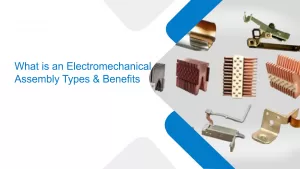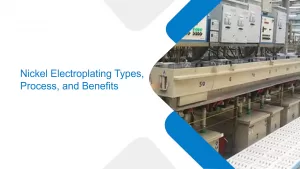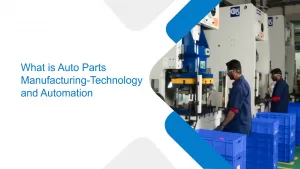What Are the Stamped Aerospace Parts & Material Used in Component Manufacturing
- Aerospace |
- Jun 21, 2024

There is no margin for error in the aircraft sector, and everything needs to be flawless. The aircraft industry has highly strict standards, therefore there is no room for error. From concept to production, manufacturers of aerospace components have to stick to strict quality standards.
With this approach, materials and manufacturing processes for aerospace parts are precise and high-quality that adhere to the right standards. Aerospace component producers can use this approach to create metal parts of any size and with a wide range of capabilities. Stay here to know about the stamped aerospace parts & materials used in component manufacturing:
What are Stamped Aerospace Parts?
Stamped aerospace parts include a wide variety of elements essential to the operation of airplanes. These components include structural elements, panels, housings, clips, connectors, and brackets. Each part is meticulously constructed to fulfil demanding performance standards, endure harsh environments, and guarantee the dependability and safety of aerospace vehicles.
Stamped Aerospace Parts:
Manufacturers of aerospace components produce a variety of metal-stamped parts, some of which are utilized most frequently:
Interior Components
Interior components enhance aerospace vehicle comfort, usability, and aesthetics. Select the best firm for the materials and manufacturing processes aerospace parts such as overhead bins, cabin panels, seat tracks, and restroom fittings. These parts are designed to maximize passenger comfort, cabin ambiance, and space usage.
Pressurization System and Oxygen Generation
To maintain the air in the cockpits and aircraft cabs, fresh pressurization systems and oxygen generators are securely compressed at altitude using valves and compressors constructed of metal-stamped components.
Control Surfaces
Aerospace vehicle attitude, and direction can be changed and controlled by pilots and spacecraft operators via control surfaces. Ailerons, elevators, rudders, flaps, and thrust reversers are stamped control surface components essential to achieving stable and controllable flight operations. Switches and relays with metal stamping parts regulate how much electricity an aircraft generates.
Instruments
Metal-stamped components are included in several vital equipment to ensure the safety of airplane operations, including fuel gauges, altimeters, pressure sensors, and compasses. Additionally, internal and external aerospace lighting equipment uses metal-stamped components.
Structural Components
Aerospace vehicles are primarily composed of structural elements that offer support, stability, and strength. The fuselage frames, wing ribs, bulkheads, and floor beams are stamped structural parts essential to preserving the structural integrity and aerodynamic efficiency of airplanes and spacecraft.
Control System
When it comes to buying flight control systems, which include metal-stamped parts such as flaps, elevators, stabilizers, and spoilers, to measure and regulate the direction, altitude, and speed of an aircraft are manufactured by the skilled aerospace components manufacturers.
Aerostructures
Aerostructures are the amicably structured parts directly interacting with airflow during flight. Wing skins, tail surfaces, fairings, and engine nacelles are stamped aerostructure components designed to reduce drag, increase performance, and improve fuel efficiency.
Fasteners and Connectors
Connectors and fasteners are required to join different assemblies and components. This category of stamped aerospace components includes connections for hydraulic, pneumatic, and electrical systems as addition to fastening instruments such as bolts, nuts, rivets, and clips.
Engine Systems
Fuel systems distribute and store gasoline in airplane engines. The gasoline system utilizes metal-stamped parts such as tanks, pipelines, pumps, valves, and others.
Material Used in Component Manufacturing
Copper
As a pure metal, copper may be stamped into many pieces, but it is also valuable in various alloys. Copper alloys contain an array of precious metals, such as bronze, brass, nickel, silver, and more. Due to their adaptability, copper and its related alloys are among the best materials for metal stamping.
Aluminium
Aluminium has special qualities and makes excellent applications. Because of their low weight, metals are perfect for applications at far-off places that need to be transported and for structures that need to be strong without adding extra weight. Although Aluminium alloys are ductile and corrosion-resistant, they are frequently more costly than comparable steel components.
Titanium
The exceptional weight ratio, corrosion resistance, and high temperature characteristics of titanium make it a vital material in aeronautical engineering. Important aircraft equipment like landing gear, engines, and structural reinforcing elements are made of stamped titanium.
Due to its exceptional quality, titanium is highly popular, make it worthwhile to utilize in applications where durability and performance are essential.
Also Read: The Crucial Role of Metal Stamping in Precision Components for Aerospace
Steel
Steel is a good metal that is frequently utilized because of its durability and strength. It can be built in a variety of ways to create components and items in different sizes, shapes, and configurations.
Steel is an excellent option for producers searching for reasonably priced metal stamping because it is affordable one. However, steel is hefty, so there might be better choices in some situations.
Winding Up
Eigen is the right place to visit for materials and manufacturing processes for aerospace parts. They produce intricate, near tolerance precision stamped components, and sub-assemblies for the Indian and international markets in Europe and the USA.
Ujjwal handles crucial roles like AGM Marketing, researcher, and is an author for KDDL – Eigen. He currently works with Eigen for implementing proven techniques and strategies for marketing plans on online and offline platforms. An expert in efficiently executing SEO, SEM, email marketing, social media marketing, PR marketing, Print campaigns, etc. Ujjwal has coordinated an efficient marketing team on various creative campaigns and programmatic buying to support various digital cross-promotion efforts. Implement efficient search optimization strategies with the help of collateral material and metrics.
In his former years, Ujjwal has years of experience in a managerial role for several reputed companies. His years of experience combined with the flair of writing help him come up with result oriented strategies for Eigen.




